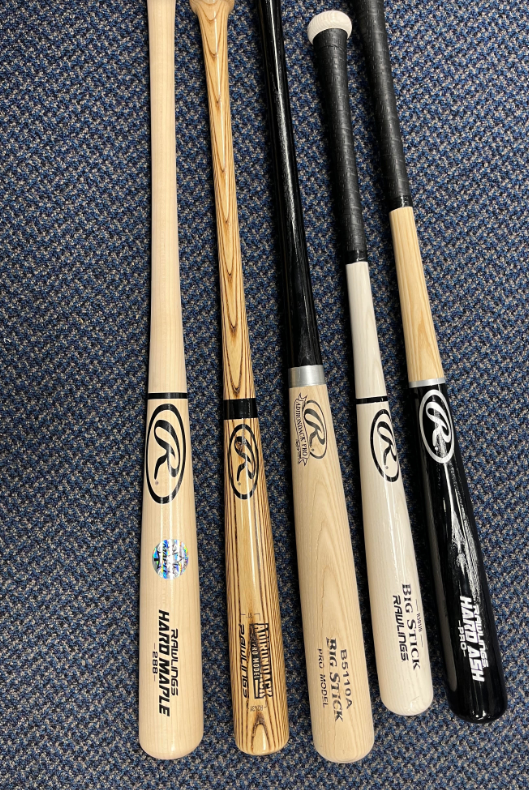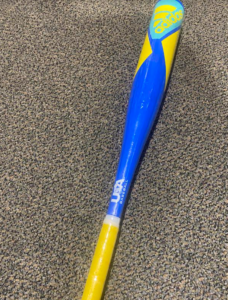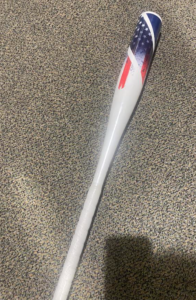A “drop” on a baseball bat refers to the difference between the bat length and bat weight of the baseball bat. Baseball bats are measured in inches and ounces. The drop requirement changes at each level, and the pros can do whatever they want.
So if a bat is a -3 (minus 3, you may commonly hear it referred to), that means it is 3 ounces lighter than it is long. For example, a 33” bat would be a 30oz bat if it was a minus 3. A 34” 31oz bat would also be a minus 3, as would a 32” 29oz bat, and so on and so forth.
Contents
Drops on Metal vs. Wood bats
Metal bats are made to fit the guidelines for a specified level of play. Wood youth baseball bats are naturally a bit heavier and are commonly in the -1.5 to -2 range. Some companies have a “light” version, which generally refers to the bat being a minus 3.
However, a wood bat can be made to many different specifications and seeing how big and strong professional players are. It is not uncommon for them to swing a bat that is actually heavier than the length of the bat.
Drop requirements and recommendations at different levels of play
Tball
For T-Ball, the most common drop is -10. Depending on their size and strength, some kids may need a bigger drop, such as a -12 or -14. There is no official requirement for a drop in T-Ball though.
Little League
For Little League rules, the most common drops range from -8 to -10.
There is no specific drop for Little League baseball, but the requirements do say that bats “shall not be more than 33 inches in length; nor more than 2⅝ inches in diameter, and if wood, not less than fifteen-sixteenths (15/16) inches in diameter (7/8 inch for bats less than 30″) at its smallest part.
Wood bats taped or fitted with a sleeve may not exceed sixteen (16) inches from the small end.”
Junior League
For Intermediate division and Junior League, the requirements “shall not be more than 34″ inches in length; nor more than 2⅝ inches in diameter, and if wood, not less than fifteen-sixteenths (15/16) inches in diameter (7/8 inch for bats less than 30″) at its smallest part.
Wood bats taped or fitted with a sleeve may not exceed eighteen (18) inches from the small end.”
Senior Little League
For Senior Little League, bat requirements “shall not be more than 36 inches in length, nor more than 2⅝ inches in diameter, and if wood, not less than fifteen-sixteenths (15/16) inches in diameter (7/8 inch for bats less than 30″) at its smallest part.
Wood bats taped or fitted with a sleeve may not exceed eighteen (18) inches from the small end.
The wood baseball bat shall not weigh, numerically, more than three ounces less than the length of the bat (e.g., a 33-inch-long bat cannot weigh less than 30 ounces).
All bats not made of a single piece of wood shall meet the Batted Ball Coefficient of Restitution (BBCOR) performance standard.
Such baseball bats shall be labeled with a silkscreen or other permanent certification mark.
The certification mark shall be rectangular, a minimum of a half-inch on each side and located on the barrel of the baseball bat in any contrasting color. Aluminum/alloy and composite bats shall be marked as to their material makeup being aluminum/alloy or composite.
This marking shall be silkscreen or other permanent certification marks, a minimum of one-half-inch on each side, and located on the bat’s barrel in any contrasting color.”
High School Bat Drop
For High School, it gets a lot more complex, but the rules for baseball bat drops are very simple.
A bat cannot have a bigger drop than a -3. They must also be between 31” in bat length and 36” in bat length and have a certified stamp on the bat that shows they are approved for competition at the high school level.
For detailed NFHS bat standards read on…
The bat shall have the following characteristics and components.
a. Each legal wood, aluminum or composite bat shall:
- Be one piece, multi-pieces and permanently assembled, or two pieces with interchangeable barrel construction.
- Not have exposed attachments, rivets, pins, rough or sharp edges, or any exterior fastener that would present a potential hazard.
- Be free of rattles, dents, burrs, cracks and sharp edges. Bats that are broken, altered or that deface the ball are illegal. Materials inside the bat or treatments/devices used to alter the bat specifications and/or enhance performance are prohibited and render the bat illegal.
b. Each legal wood, aluminum or composite bat shall have the following components:
- Knob – The bat knob shall protrude from the handle. The knob may be molded, lathed, welded or permanently fastened. Wrappings are permitted except those that cause the knob to become flush with the handle. A one-piece rubber knob and bat grip combination is illegal.
- Handle – The bat handle is the area of the bat that begins at, but does not include, the knob and ends where the taper begins.
- Barrel – The barrel is the area intended for contact with a pitched ball. The barrel shall be round, cylindrically symmetric, with a smooth contour. The barrel may be aluminum, wood or composite (made of two or more materials). The type of bat (wood, aluminum or composite) shall be determined by the composition of the barrel.
- Taper – The taper is an optional transition area that connects the narrower handle to the wider barrel portion of the bat. Its length and material may vary but may not extend more than 18 inches from the base of the knob.
- End Cap – The end cap is made of rubber, vinyl, plastic or other approved material. It shall be firmly secured and permanently affixed to the end of the bat so that it cannot be removed by anyone other than the manufacturer without damaging or destroying it. By definition, a one-piece construction bat does not have an end cap.
c. Each bat not made of a single piece of wood shall:
- Have a safety grip made of cork, tape (no smooth, plastic tape) or commercially manufactured composition material. The grip must extend a minimum of 10 inches, but not more than 18 inches, from the base of the knob. Slippery tape or similar material shall be prohibited. Resin, pine tar or any drying agent to enhance the hold is permitted only on the grip. Molded grips are illegal.
- Be 2 5/8” or less in diameter at the thickest part and 36 inches or less in length.
- Not weigh, numerically, more than three ounces less than the length of the bat (e.g., a 33-inch-long bat cannot be less than 30 ounces).
d. Bats that are not made of a single piece of wood shall meet the Batted Ball Coefficient of Restitution (BBCOR) performance standard, and such bats shall be labeled with a silkscreen or other permanent certification mark.
- No BBCOR label, sticker, or decal will be accepted on any non-wood bat. The certification mark shall be rectangular, a minimum of one inch on each side, and located on the barrel of the bat in any contrasting color to read: “BBCOR .50.” NOTE:
- The NFHS has been advised that certain manufacturers consider alteration, modification and “doctoring” of their bats to be unlawful and subject to civil and, under certain circumstances, criminal action.
For College, it’s basically the same as high school. A bat cannot have a bigger drop than a -3. These bats must also be between 31” and 36” and have a certified stamp to show they are approved for competition at the college level.
For more, read on…
SECTION 12.
a. Wood bat.
- The bat must be a smooth, rounded stick not more than 2¾ inches in diameter at its thickest part nor more than 42 inches in length.
- There must be a direct line from the center of the knob to the center of the large end.
- Any material to improve the grip may be used for a distance not to exceed 18 inches from the end of the handle.
- An indentation in the end of the bat up to 1 inch in depth is permitted (cupped bats).
- All bats other than one-piece solid wood must be certified in accordance with the NCAA certification program.
b. Nonwood bat.
- The entire hitting area of the bat must be round with a constant radius at any point and the finish of the hitting area must be smooth.
- There must be a direct line from the center of the knob to the center of the large end.
- The maximum length is 36 inches and the maximum diameter is 2 5/8 inches.
- The knob and end plug (if applicable) must be firmly attached.
- A bat may not weigh, numerically, more than three units less than the length of the bat (e.g., a 34-inch-long bat cannot weigh less than 31 ounces).
- A nonwood bat must have an approved, coded certification mark on the barrel of the bat, signifying the bat is legal for NCAA competition.
- Beginning in the 2020 NCAA Championship segment, the bat barrel color must predominantly contrast with the baseball color between the 18-inch mark and the end cap.
PENALTY
for a. and b.—A bat that has been flattened or altered to improve performance is an illegal bat. If such an illegal bat is detected before the first pitch, the batter shall be called out, and the bat shall be removed from the game. If an illegal bat is detected after the first pitch, legal or illegal, the batter shall be declared out, and base runners shall not advance due to a batted ball. The bat shall be removed from the contest.
c. There shall be no external attachment(s) to any part of the bat. A leather, rubber or taped grip is permitted to be placed on the bat handle.
d. There shall be no data collection or transmission devices externally attached or embedded within any part of the baseball bat.
e. It is mandatory that all bats have an identification mark 18 inches from the end of the handle. No foreign substance that will discolor the ball may be added to the bat’s surface beyond 18 inches from the end of the handle.
f. For game and practice use, all nonwood bats must have a leather, rubber or taped grip securely attached to the bat handle.
PENALTY
for e. and f.—If the bat is not marked 18 inches from the knob, or has pine tar or a foreign substance beyond the 18-inch mark, the bat must be removed from the game and the player warned. If the practice continues, the player is to be removed from the game. If a bat’s handle should become loose and the bat must be removed from the game, the same practice is to be followed. Neither of these infractions is cause for calling the batter out.
G. Beginning with the 2020 NCAA Championship segment for Division I and the 2021 NCAA Championship segment for Divisions II and III, baseball bat barrel compression testing will be conducted before each regular season series or single date of competition.
All bats used in competition must pass the barrel ring test and barrel compression testing. Barrel compression minimum standards for bats produced with specific materials are developed by the certification laboratory and will be published with the list of approved baseball bats.
For Professionals, a wood bat is required; no drop specification, though. These bats have no minimum or maximum length, however. They must be wood, not composite or metal, and have certain specifications for barrel size, handle, etc. Still, all things considered, the widest variety of bats can be used at the professional level.
Final Word
It’s important to stay on top of all of the bat changes if you have a young player. The rules change from time to time, and you need to ensure the bat you provide meets league and rule standards. We hope this article provided some clarity on bat drops and the drop rules at each of the different baseball levels!




